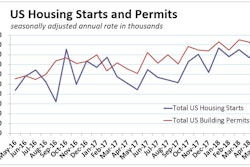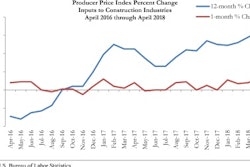Construction News Tracker is presented by Caterpillar and produced by ForConstructionPros.com.
May U.S. housing starts continued to set cycle highs, outstripping forecasts with a 5% leap to a 1.35 million unit seasonally adjusted annual pace. A staggering 62.2% surge in Midwestern starts was responsible for all of the country's gain. Permit declines in the South and West drove May's total U.S. permits 4.6% lower. Nevertheless, year-to-date U.S. starts are 11% above the same period of 2017. Builders have started 9.8% more single family and 13.7% more multifamily construction since the first of the year.
Construction materials prices surged to their highest level in a decade last month, according to ABC. Chief Economist Anirban Basu says the 2.2% expansion in May is now 8.8% higher than one year ago and the highest in 10 years. It's bad news for the construction industry. Inflationary pressures are building in labor markets as well as in the cost of gasoline and health care. If these pressures continue, one can see real estate and construction cycles become vulnerable to higher borrowing costs as well. Policy making has caused construction materials prices to surge, led by metals and softwood lumber costs.
The U.S DOT has released more than $1.5 billion in grants under the Infrastructure for Rebuilding America program. Known as Infra, that is a creation of the FAST Act from 2015. Twenty-six projects nationwide will receive the $1.535 billion to fund critical freight, highway and bridge improvements. Eighteen of the 26 projects come under state DOT administration including the following:
- $184 million for the Georgia Highway 400 express lane project
- $160 million to Wisconsin for expansion of Interstate 94 between Milwaukee and the Illinois border due to the massive Foxconn plant construction
- $147 million to North Carolina for its I-95/ U.S. 70 corridor improvements.
The U.S. House has approved the $3 billion Water Resources Development Act. It seeks to improve the nation's ports, dams and harbors against floods, restore shorelines and support other water related projects. Just one of the projects earmarked by the legislation is a billion dollars to stem coastal erosion at Galveston, Texas, and restore wetlands destroyed by Hurricane Harvey. The bill would spend to widen the Savannah, GA, harbor and direct the Army Corps of Engineers to study two dozen flood risk projects.
Economists at the Trade Partnership have revealed some interesting statistics relating to the imposition of steel and aluminum tariffs by the Trump administration. While the tariffs, quotas and retaliation would increase those industries employment by 26,000 plus jobs over the next three years, net employment would be reduced by 432,747 jobs throughout the balance of the economy leaving a total net job loss of 400,445. The economists claim 16 jobs would be lost nationwide for every steel and aluminum job gained, with 2/3rds of the loss from production and low wage positions. And immigration has no effect on U.S. job prospects.
The American Association of Port Authorities projects $20 billion will be needed in port access and multi-modal rail over the next 10 years. Addressing the inadequacy of transportation in and out of the nation's ports, the association cites the critical need as the population grows and more goods are shipped. Thirty percent of the association's membership has identified $50 million in rail projects and $77 million in near dock and surface transportation port needs over the next five years. The DOT’s FAST Act freight funding has allocated only $1.1 billion to multi-modal projects while some $155 billion is what’s needed.
Construction loan software provider Contract Simply claims in a recent report that customer late payments cost the commercial construction industry $40 billion annually. The study, conducted along with Building Connected and covering 1,300 respondents from a variety of trades, claims the following:
- 88% of contractors wait more than 30 days for payment
- 46% cover the shortfall with personal or business savings and credit lines
- 80% of contractors have been forced to file mechanics liens in order to get their payments
The study also says 70% of contractors would be willing to offer a discount if customers would pay in full on time, which would put $18 billion back into the commercial building pipeline.
Finally, a wise leader remembers that people perceive service in their own terms.
This is Construction News Tracker looking over the industry that makes the world a better place, presented by Caterpillar and produced by ForConstructionPros.com.
Follow us on social media at Twitter using #constructionnews,YouTube and Facebook as the streaming Web never ends.



















